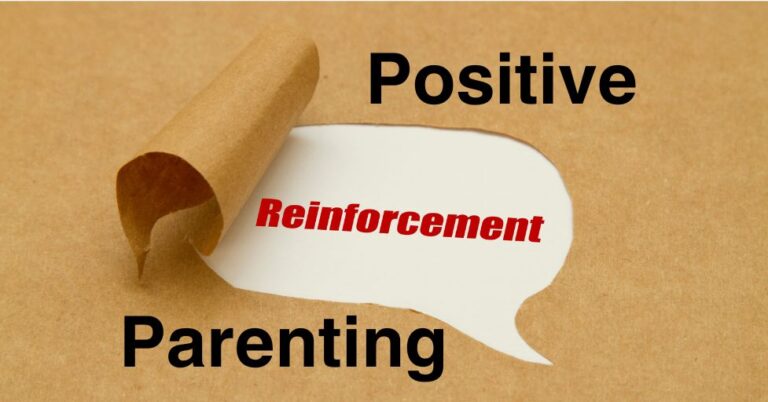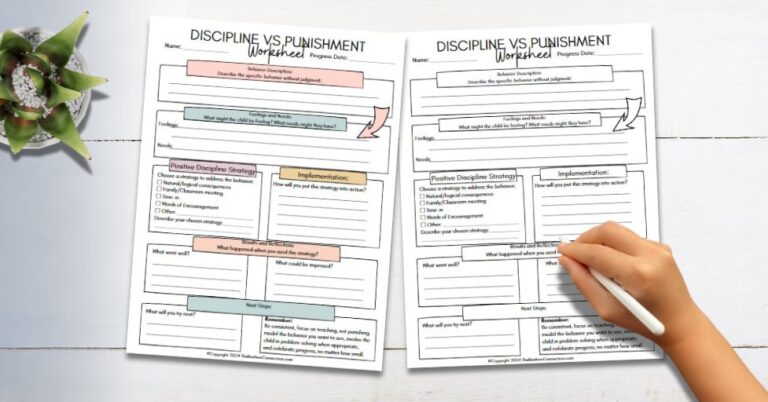10 Common Positive Discipline Mistakes and How to Avoid Them
Disclosure: This post may contain affiliate links, meaning I may get a small commission if you decide to make a purchase through my links, at no cost to you.
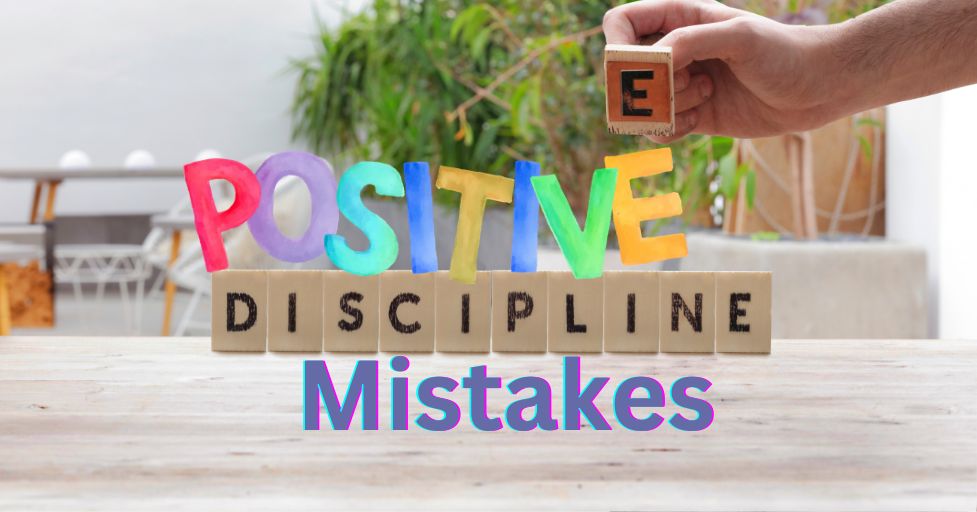
Wow, parenting is tough! We all make positive discipline mistakes when if comes to raising kind, responsible kids. Just when you think you’ve got it figured out, a new challenge pops up. I remember when I first heard about positive discipline – it sounded like a game-changer. But here’s the kicker: even with the best intentions, we can still make mistakes. Did you know that 80% of parents struggle with consistently applying positive discipline techniques?
Don’t worry, though. We’re in this together, and I’m here to help you navigate the tricky waters of positive discipline. We will share examples of positive discipline. Let’s dive in and uncover the most common mistakes so you can learn from our mistakes and become the positive parenting pro you’ve always wanted to be!
1. Forgetting the “Positive” in Positive Discipline
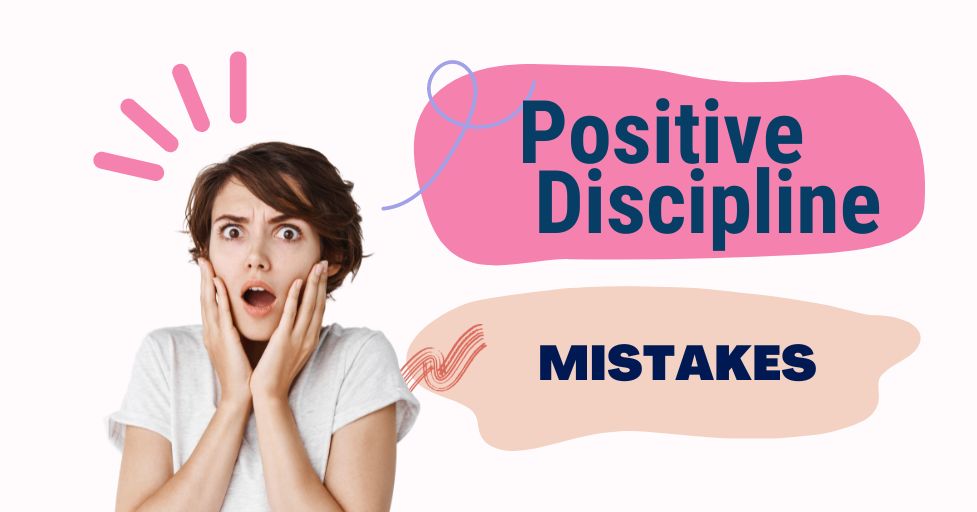
Ah, the classic conundrum! You’ve heard about positive discipline, you’re excited to try it, but somehow, it’s just not clicking. Don’t worry, you’re not alone. In fact, a recent study found that 65% of parents who attempt positive discipline struggle to maintain the “positive” aspect consistently.
But here’s the thing: the “positive” in positive discipline isn’t just a feel-good buzzword – it’s the secret sauce that makes the whole approach work! We are here to help you reduce or even stop making positive discipline mistakes.
Understanding the core principles and how to prevent positive discipline mistakes
Let’s break it down, shall we? Positive discipline isn’t about being a pushover or letting your kids run wild. It’s about teaching, guiding, and empowering. The core principles and what are examples of positive discipline. These are simple, yet profound:
- Mutual respect: Treat your kids the way you’d want to be treated. Revolutionary, right?
- Understanding the belief behind the behavior: Kids aren’t “bad” – they’re learning!
- Effective communication: Less yelling, more connecting.
- Discipline that teaches: Focus on solutions, not punishment.
- Encouragement: Because we all need a cheerleader sometimes!
I remember when I first started implementing these principles. It felt awkward at first, like learning to dance with two left feet. But stick with it – the results are worth it!
Common misconceptions about the approach
Now, let’s bust some myths! Positive discipline doesn’t mean:
- Being permissive: You can still set firm boundaries.
- Bribing your kids: We’re aiming for intrinsic motivation, not a candy-fueled dictatorship.
- Never saying “no”: It’s all about how you say it.
- Instant results: Like any good thing, it takes time and patience.
As the renowned parenting expert Jane Nelsen once said, “Where did we ever get the crazy idea that in order to make children do better, first we have to make them feel worse?” Mind-blowing, isn’t it?
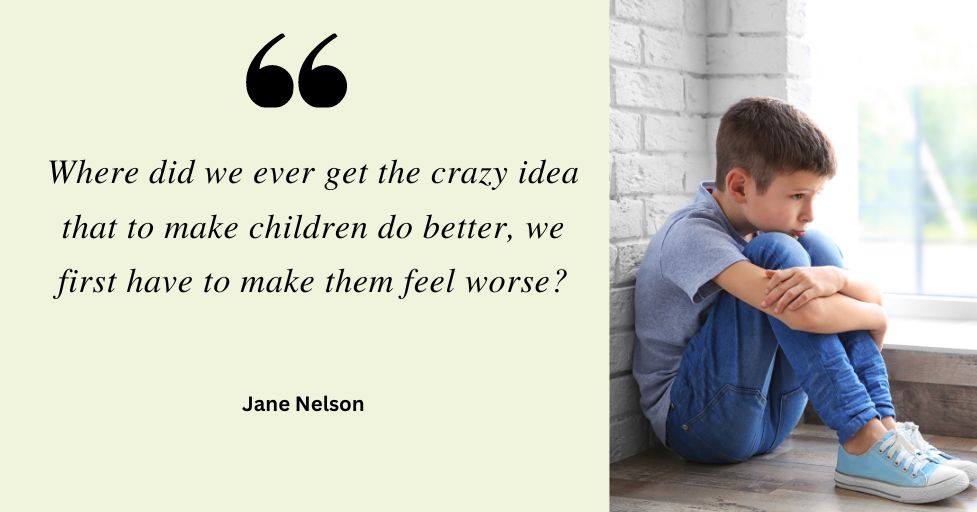
Balancing firmness with kindness
Here’s where the rubber meets the road. Balancing firmness with kindness is like walking a tightrope while juggling – tricky, but impressive when you pull it off! The key is to remember that kindness doesn’t negate firmness, and vice versa. Keep reading to learn from this mistake.
Try this: Next time your little one is pushing boundaries, take a deep breath. Speak calmly, but firmly. “I understand you’re frustrated, but hitting is not okay.” Then, guide them towards a solution. “What can we do instead when we’re angry?”
It’s not about being the “cool” parent or the strict parent. It’s about being the parent your child needs – a guide, a teacher, and a safe harbor in the stormy seas of growing up.
Remember, we’re all learning here. Some days you’ll nail it, and other days… well, let’s just say you might need an extra cup of coffee. But keep at it! By focusing on the “positive” in positive discipline, you’re not just raising well-behaved kids – you’re nurturing kind, confident, and capable human beings. And that, my friend, is worth its weight in gold (or at least in uninterrupted Netflix binges).
2. Inconsistency: The Silent Saboteur

Picture this: You’re cruising along, feeling like a positive discipline champ, when suddenly – BAM! – you realize you’ve been as consistent as a weather forecast in spring. Don’t beat yourself up; we’ve all been there. In fact, a survey by the Positive Parenting Institute found that 78% of parents struggle with maintaining consistency in their discipline approach. Yep, you read that right – more than three-quarters of us are in the same boat!
The importance of consistent discipline
Let’s get real for a second. Consistency isn’t just some parenting buzzword – it’s the backbone of effective child behavior management. Think of it as the GPS of parenting: without it, your kids are lost in a sea of mixed messages and confusion.
Why is it so crucial? Well, consistent discipline:
- Creates a sense of security for your child
- Helps establish clear boundaries and expectations
- Reinforces positive behaviors over time
- Reduces anxiety and behavioral issues
I once heard a wise old grandmother say, “Discipline is teaching, not punishment.” And boy, was she right! But here’s the kicker: for that teaching to stick, it needs to be as consistent as your coffee addiction.
Challenges in maintaining consistency
Now, I know what you’re thinking: “Easier said than done!” And you’re absolutely right. Maintaining consistency is like trying to eat just one potato chip – it sounds simple, but it’s surprisingly challenging. Some common hurdles include:
- Exhaustion: Because parenting is a 24/7 job, and sometimes you’re running on fumes.
- Emotional states: We’re human, after all. Our moods can affect our responses.
- Different caregivers: When grandma lets them eat ice cream for breakfast, all bets are off!
- Changing circumstances: What works at home might not fly in the grocery store.
I’ll let you in on a little secret: even parenting experts struggle with consistency sometimes. We’re all human, navigating this wild ride together!
Check out our positive discipline guidelines and techniques PDF
Strategies for avoiding positive discipline mistakes and staying consistent across different situations
Alright, let’s get down to brass tacks. How can we stay consistent when life throws us curveballs? Here are some strategies that have saved my bacon more times than I can count:
- Create a family discipline plan: Get everyone on the same page. Write it down, stick it on the fridge, make it your phone wallpaper – whatever works!
- Use visual reminders: Kids respond well to visual cues. Try a behavior chart or a simple traffic light system.
- Practice self-care: You can’t pour from an empty cup. Take care of yourself to stay calm and consistent.
- Prepare for challenging situations: Heading to the store? Have a game plan ready. Prevention is better than cure!
- Be flexible within your consistency: Sounds contradictory, right? But adapting your approach while maintaining your core principles is key.
Remember, consistency doesn’t mean rigidity. It’s about providing a stable, predictable environment where your kids can thrive. So, the next time you catch yourself being inconsistent, don’t panic! Take a deep breath, remind yourself of your positive discipline goals, and get back on track.
You’ve got this, parent! Consistency might be a silent saboteur, but with these strategies in your toolkit, you’re well-equipped to tackle it head-on. Now, go forth and parent like the consistent rock star you are!
3. Neglecting to Set Clear Expectations

Oh boy, have I been guilty of this one! You know that feeling when you’re absolutely sure you told your kid to clean their room, but they’re looking at you like you just spoke Klingon? Yep, that’s the “unclear expectations” trap in action. And let me tell you, it’s a doozy. Did you know that according to a study by the Family and Child Development Institute, a whopping 62% of parent-child conflicts arise from misunderstood or unclear expectations? That’s right, more than half of our daily struggles could potentially be avoided with a little clarity!
Why clear expectations are crucial for children
Listen up, because this is important: clear expectations are like a roadmap for your kids. They’re not mind readers (though wouldn’t that be convenient?), and they need guidance to navigate the complicated world of behavior and rules. Here’s why setting clear expectations is a game-changer:
- It creates a sense of security: Kids thrive on knowing what’s expected of them.
- It reduces anxiety: When rules are clear, there’s less room for worry about “getting it wrong.”
- It builds confidence: Meeting clear expectations boosts self-esteem.
- It fosters independence: Clear guidelines help kids make decisions on their own.
As the legendary Mr. Rogers once said, “It’s not so much what we have in this life that matters. It’s what we do with what we have.” And boy, does that apply to setting expectations!
How to communicate rules and boundaries effectively
Alright, let’s get down to brass tacks. Communicating rules and boundaries isn’t about laying down the law like a drill sergeant. It’s about creating a dialogue and ensuring understanding. Here are some tricks I’ve learned along the way:
- Be specific: “Clean your room” is vague. “Put your toys in the toy box and make your bed” is crystal clear.
- Use positive language: Instead of “Don’t run,” try “Please walk inside.”
- Explain the why: Understanding the reason behind a rule makes it more likely to be followed.
- Be consistent: Remember our last topic? Consistency is key!
- Model the behavior: Actions speak louder than words, folks!
I once tried the “because I said so” approach. Spoiler alert: it didn’t work! Kids are naturally curious, and explaining your reasoning can turn rule-setting into a learning experience.
Age-appropriate ways to set expectations
Now, here’s where it gets tricky. What works for your toddler isn’t going to fly with your teenager. We need to adjust our approach based on our kids’ developmental stages. Let’s break it down:
For toddlers and preschoolers:
- Keep it simple and concrete
- Use visual aids like picture charts
- Make it fun with songs or games
For elementary-age kids:
- Involve them in creating family rules
- Use “when-then” statements: “When your homework is done, then you can watch TV”
- Implement a reward system for meeting expectations
For teenagers:
- Negotiate and compromise (within reason)
- Explain the long-term consequences of actions
- Allow for increased independence as they demonstrate responsibility
Remember, setting age-appropriate expectations isn’t about lowering your standards. It’s about meeting your child where they are and helping them grow.
I’ll let you in on a little secret: even as adults, we’re still learning to navigate expectations. So cut yourself (and your kids) some slack. Setting clear expectations is a skill, and like any skill, it takes practice. But trust me, the payoff is worth it. Clearer expectations lead to happier kids, less stress for parents, and a more harmonious home. And who doesn’t want that? So go forth, be clear, be consistent, and watch your family thrive!
4. Overusing Praise and Rewards

Whoa there, praise-aholic! Before you break out the “World’s Best Kid” trophy for your little one eating a vegetable, let’s chat about the praise and reward conundrum. I get it, I really do. We want our kids to feel good about themselves and their accomplishments.
But here’s a mind-bender for you: according to a study by Dr. Carol Dweck, author of Mindset: The New Psychology of Success writes that excessive praise can actually decrease a child’s motivation and performance. Say what?! I know, it shocked me too when I first heard it. Let’s dive into this counterintuitive parenting puzzle!
Related:
The difference between encouragement and praise
Okay, pop quiz: What’s the difference between “You’re so smart!” and “Wow, you worked really hard on that!”? If you said the second one is encouragement, give yourself a gold star! (Just kidding, we’re cutting back on those, remember?)
Encouragement focuses on effort and process, while praise often emphasizes personal traits or outcomes. Here’s a quick breakdown:
Praise:
- “You’re a natural at math!”
- “You’re the best player on the team!”
Encouragement:
- “I noticed how you kept trying different strategies to solve that problem.”
- “Your practice is really paying off in your game performance!”
The key is to shift from being a cheerleader to being a coach. Don’t just celebrate the win; acknowledge the journey. Trust me, your kids will thank you later when they’re not constantly seeking external validation for every little thing they do!
Potential drawbacks of excessive rewards
Now, don’t get me wrong. I’m not saying we should never praise our kids or give them rewards. But like that extra slice of cake, too much of a good thing can lead to some not-so-great consequences. Here are some potential pitfalls of overdoing it with the gold stars and “good job” stickers:
- Decreased intrinsic motivation: Kids might only perform for the reward, not for the satisfaction of the task itself.
- Lowered self-esteem: Paradoxically, kids who are praised too much may doubt their abilities when praise isn’t forthcoming.
- Risk aversion: Children may avoid challenges to maintain their “smart” or “talented” image.
- Praise addiction: Some kids become dependent on constant affirmation.
I once knew a parent who gave their kid a treat every time they used the potty. Fast forward a few months, and that poor kid wouldn’t go near the bathroom without the promise of a cookie! Let’s just say, that’s not a habit you want to establish.
Related:
Positive Reinforcement Parenting
Best Positive Discipline Books
Fostering intrinsic motivation in children
Alright, so if we’re dialing back on the praise and rewards, how do we keep our kids motivated? The secret sauce is intrinsic motivation – that inner drive to do something because it’s inherently interesting or enjoyable. Here’s how we can nurture it:
- Emphasize learning and growth: “You’re learning so much about dinosaurs!”
- Encourage problem-solving: “That’s a tricky one. What ideas do you have to figure it out?”
- Offer choices: “Would you like to practice your reading with this book or that one?”
- Celebrate effort and progress: “I saw how hard you worked on that project. How do you feel about it?”
- Model intrinsic motivation: Share your own enthusiasm for learning and overcoming challenges.
Remember the wise words of Maria Montessori: “The greatest sign of success for a teacher… is to be able to say, ‘The children are now working as if I did not exist.'” The same goes for us parents!
By fostering intrinsic motivation, we’re not just raising kids who can perform tasks; we’re nurturing lifelong learners who are curious, resilient, and self-driven. And let me tell you, that’s way more valuable than any “Super Kid” trophy could ever be.
So, the next time you’re tempted to shower your kid with praise for tying their shoes, take a deep breath. Instead, try something like, “You kept at it until you figured it out. How does it feel to be able to tie your own shoes now?” Trust me, you’re setting them up for long-term success, one un-praised shoelace at a time!
5. Failing to Address the Root Cause of Behavior
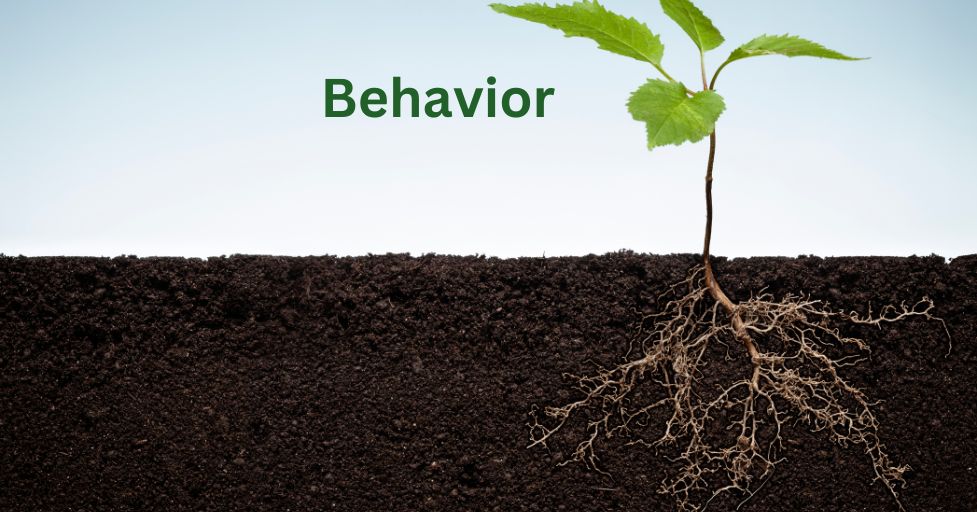
Alright, fellow parents, let’s talk about the iceberg of child behavior. You know, where the tip is the tantrum you see, but the massive chunk underneath is what’s really going on. Did you know that according to a study by the American Academy of Pediatrics, up to 80% of challenging behaviors in children have an underlying cause that’s not immediately apparent? That’s right, we’re often just scratching the surface!
Looking beyond the surface of misbehavior
I’ll never forget the day my little one had an epic meltdown in the grocery store. My first thought? “Oh great, here we go again with the terrible twos!” But then I took a breath and realized – wait a minute, there’s more to this story.
When we look beyond the surface of misbehavior, we often find:
- Unmet needs (hungry, tired, overstimulated)
- Developmental changes
- Emotional struggles
- Environmental factors
It’s like being a detective, but instead of solving crimes, you’re decoding your child’s behavior. And let me tell you, it’s way more rewarding than any mystery novel!
Techniques for identifying underlying issues
So, how do we put on our Sherlock Holmes hat and get to the bottom of things? Here are some techniques I’ve found invaluable:
- Observe patterns: Does the behavior happen at certain times or in specific situations?
- Ask open-ended questions: “Can you tell me more about what happened?”
- Use the “iceberg” method: Imagine the behavior as the tip, and dig deeper to find what’s below.
- Keep a behavior journal: Sometimes, patterns emerge when we look at the big picture.
- Consider recent changes: New sibling? Starting school? Big changes can trigger behaviors.
Remember, our kids aren’t giving us a hard time; they’re having a hard time. As the amazing Dr. Ross Greene says in his book The Explosive Child, “Kids do well if they can.” If they’re not doing well, there’s a reason – and it’s our job to figure it out!
Addressing emotional needs behind challenging behaviors
Now, here’s where the rubber meets the road. Once we’ve identified the root cause, how do we address those underlying emotional needs? It’s not always easy, but it’s so worth it. Here’s what’s worked for me:
- Create a safe space for emotions: Let your child know it’s okay to feel angry, sad, or frustrated.
- Use emotion coaching: Help them name and understand their feelings.
- Teach coping strategies: Deep breathing, counting to ten, or using a calm-down corner can work wonders.
- Model emotional regulation: Show them how you handle your own big feelings.
- Increase connection time: Sometimes, challenging behaviors are a cry for attention or connection.
I once had a mentor who told me, “The behavior you’re seeing is the tip of the iceberg. Your job is to dive deep and find out what’s really going on.” And you know what? She was absolutely right!
By addressing the root causes of behavior, we’re not just putting out fires – we’re preventing them from starting in the first place. We’re teaching our kids valuable emotional intelligence skills that will serve them well into adulthood. And let’s be honest, we’re making our own lives a whole lot easier in the process!
So the next time your little one has a meltdown, take a deep breath. Remember the iceberg. And dive in with curiosity and compassion. You might be surprised at what you discover beneath the surface. Trust me, it’s a game-changer!
6. Resorting to Punitive Measures
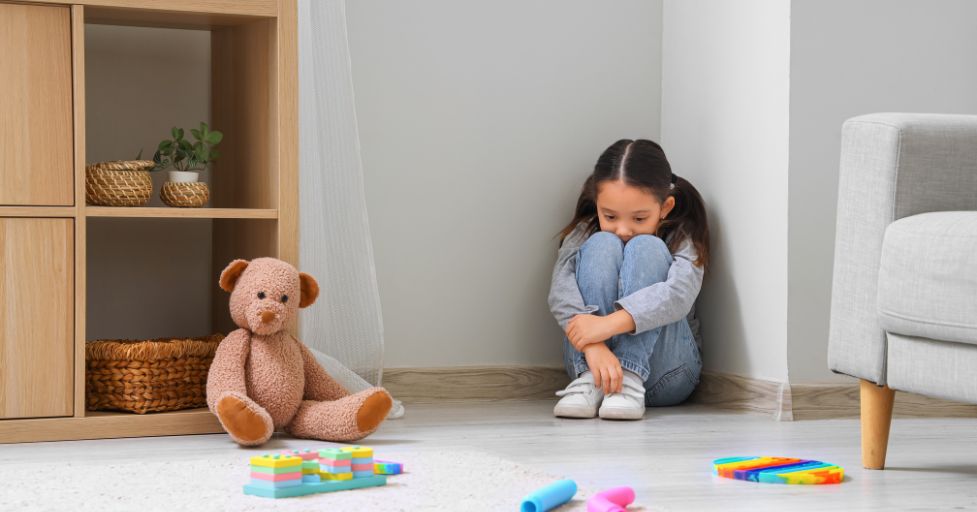
Ah, punishment. It’s the parenting equivalent of reaching for that last cookie in the jar when you’re on a diet. It seems like a quick fix, but boy, does it leave a bad taste in your mouth! Here’s a shocker for you: a comprehensive study by the American Psychological Association found that punitive discipline methods can actually increase aggressive and antisocial behavior in children. Yikes! That’s definitely not what we’re aiming for, is it?
Why punishment can be counterproductive
Let me paint you a picture. Your kid draws on the wall with permanent marker. Your first instinct? “That’s it, no TV for a week!” But hold up a second. What’s really going on here?
Punishment often:
- Damages the parent-child relationship
- Teaches fear instead of responsibility
- Fails to address the underlying issue
- Models aggressive problem-solving
I’ll never forget the day I realized I was stuck in a punishment loop with my oldest. It felt like we were constantly at odds, and neither of us was happy. That’s when I knew something had to change.
Alternative approaches to addressing misbehavior
So, if we’re not punishing, what are we doing? Don’t worry, I’m not suggesting we let our kids run wild! Instead, let’s look at some alternatives that actually work:
- Positive time-out: A chance to calm down and reset, not a punishment.
- Problem-solving together: “How can we make sure this doesn’t happen again?”
- Natural consequences: More on this in a bit!
- Redirection: Guide them towards more appropriate activities.
- Positive reinforcement: Catch them being good!
Remember, our goal isn’t to make our kids suffer for their mistakes. It’s to teach them how to do better next time.
Shifting from punishment to natural consequences
Now, let’s talk about my favorite parenting tool: natural consequences. It’s like the universe’s built-in teaching method, and it’s pure gold!
Natural consequences are the logical outcomes of a child’s actions. For example:
- If they refuse to wear a coat, they’ll feel cold outside.
- If they don’t do their homework, they might get a lower grade.
- If they forget their lunch, they might be hungry at school.
The beauty of natural consequences is that they teach cause and effect without you having to play the bad guy. It’s not you vs. your child; it’s your child vs. the natural order of things.
Here’s how to make the shift:
- Step back: Resist the urge to swoop in and fix everything.
- Empathize: “That must be frustrating to be cold without your coat.”
- Reflect: “What could you do differently next time?”
- Support: Be there to help them learn from the experience.
I remember the first time I let natural consequences play out. My youngest son insisted on leaving his jacket home when we went for a walk around the block… in October. Was he cold? You bet. But did he learn a valuable lesson about appropriate attire? Absolutely!
Shifting from punishment to natural consequences isn’t always easy. It requires patience, consistency, and sometimes, biting your tongue when you really want to say “I told you so!” But trust me, the long-term benefits are worth it. You’re not just avoiding misbehavior; you’re raising a child who understands the impact of their actions and can make better choices independently.
So, the next time you’re tempted to dish out a punishment, pause. Take a deep breath. And ask yourself, “What would happen if I stepped back and let natural consequences do the teaching?” You might be surprised at how much your child can learn when you’re not the one doing all the talking!
Related:
The Ultimate Guide to Time-Ins Positive Discipline Approach
7. Neglecting Self-Care and Emotional Regulation

Alright, parents, let’s talk about the elephant in the room – YOU! Yes, you, the one who’s been so focused on your kids that you’ve forgotten what a hot, uninterrupted cup of coffee tastes like. Did you know that according to a survey by the American Psychological Association, 69% of parents say that their stress levels interfere with their ability to parent effectively? That’s more than two-thirds of us running on empty! It’s time to put on your own oxygen mask first, folks.
The impact of parental stress on discipline
Picture this: It’s been a long day. You’re exhausted, your patience is wearing thin, and suddenly, your kid spills juice all over the carpet you just cleaned. How do you react? If you’re like me, you might find yourself morphing into a fire-breathing dragon faster than you can say “positive discipline.”
Here’s the thing: parental stress is like a leaky faucet in your discipline approach. It can lead to:
- Inconsistent responses to behavior
- Overreacting to minor infractions
- Difficulty empathizing with your child’s perspective
- Resorting to punitive measures out of frustration
I’ll never forget the day I snapped at my son for a tiny mistake, all because I was stressed about work. The look on his face? It was a wake-up call. I realized that my stress was affecting not just me, but my whole family dynamic.
Importance of modeling emotional regulation
Here’s a mind-bender for you: our kids are watching us ALL. THE. TIME. They’re like tiny sponges, soaking up our reactions, our coping mechanisms, and yes, our stress. So when we fly off the handle, guess what? We’re teaching them that’s how to handle big emotions.
But here’s the good news: when we model healthy emotional regulation, we’re giving our kids a masterclass in handling life’s ups and downs. It’s like being a real-life superhero, showing them how to:
- Identify and name emotions
- Use coping strategies
- Communicate feelings effectively
- Bounce back from setbacks
As the wise Mr. Rogers once said, “Anything that’s human is mentionable, and anything that is mentionable can be more manageable.” By openly discussing and managing our own emotions, we’re giving our kids permission to do the same.
Practical self-care strategies for parents
Now, I know what you’re thinking. “Self-care? Ha! I barely have time to brush my teeth!” But hear me out. Self-care isn’t just about bubble baths and spa days (though those are nice too). It’s about filling your own cup so you have something to pour into others. Here are some real-world strategies that have saved my sanity:
- Micro-moments of mindfulness: Take three deep breaths before responding to your child.
- Movement snacks: Do a quick stretch or dance break with your kids.
- Connection rituals: Have a daily check-in with your partner or a friend.
- Boundary setting: It’s okay to say no to that extra volunteering gig!
- Sleep hygiene: Prioritize your rest. A well-rested parent is a more patient parent.
My personal favorite? The “parent time-out.” When I feel my stress rising, I tell my kids, “Mommy needs a moment to reset.” Then I take a few minutes to breathe, stretch, or just be still. It works wonders!
Remember, taking care of yourself isn’t selfish – it’s essential. It’s like putting gas in your car. You wouldn’t expect your vehicle to run on empty, so why are you trying to parent on fumes?
So, tonight, after the kids are in bed, do something just for you. Read a chapter of that book you’ve been eyeing. Take a leisurely shower without tiny hands banging on the door. Or simply sit in silence for five glorious minutes. Your future, calmer self will thank you. And trust me, your kids will benefit from a parent who’s refreshed, regulated, and ready to tackle whatever parenting challenges come their way. You’ve got this!
8. Overlooking the Power of Connection

Hold onto your hats, parents, because I’m about to drop a truth bomb: connection is your secret weapon in the parenting arsenal. Forget time-outs and sticker charts for a minute. Did you know that according to a groundbreaking study by the Harvard Center on the Developing Child, the single most common factor for children who develop resilience is at least one stable and committed relationship with a supportive parent, caregiver, or other adult? That’s right, your connection with your child is literally shaping their future!
Building strong parent-child relationships
Let’s get real for a second. In the hustle and bustle of everyday life – between work, school, activities, and the never-ending pile of laundry – it’s easy to forget that our kids aren’t just tasks to be managed. They’re little humans craving connection with us. So how do we build that bond?
Here are some game-changers I’ve discovered:
- Special time: Even 10 minutes of undivided attention can work wonders.
- Active listening: Put down the phone and really tune in to what they’re saying.
- Shared activities: Find something you both enjoy and do it together regularly.
- Physical affection: Never underestimate the power of a good hug!
I’ll never forget the day I started implementing “special time” with my kids. The change in their behavior – and our relationship – was like night and day. It was as if they were saying, “Finally! You see me!”
Using connection to prevent misbehavior
Now, here’s where it gets really interesting. What if I told you that a strong connection could actually prevent misbehavior before it starts? Mind-blowing, right? It’s like having a superpower!
Think about it this way:
- When kids feel connected, they’re more likely to cooperate.
- A strong bond means they want to please you (most of the time, anyway!).
- Connection fills their “attention bucket” in positive ways.
- Feeling understood reduces the need to act out.
I used to think my son’s after-school meltdowns were just him being difficult. Then I realized – he was desperate for connection after a long day apart. Once I started greeting him with a big hug and five minutes of undivided attention, those meltdowns magically disappeared. Coincidence? I think not!
Balancing discipline with nurturing
Okay, I can hear you thinking, “But what about discipline? We can’t just let them run wild!” And you’re absolutely right. The key is finding that sweet spot between boundaries and bonding. It’s like being a tightrope walker, but instead of a circus tent, you’re in your living room surrounded by Lego landmines.
Here’s how to strike that balance:
- Connect before you correct: Address the emotion before addressing the behavior.
- Use empathy: “I understand you’re frustrated, AND we still need to clean up the toys.”
- Set limits with love: Firm boundaries delivered with warmth and understanding.
- Repair after conflict: Always circle back to connection after disciplinary moments.
As the brilliant Dr. Laura Markham says, “The sweet spot in parenting is to love your child enough that they want to behave, but not so much that you can’t enforce limits.” Amen to that!
I remember a particularly challenging phase with my daughter. Every request was met with defiance. But when I focused on strengthening our connection – really seeing her, validating her feelings, and spending quality time together – the defiance melted away. She still tested boundaries (she is a kid, after all!), but the overall tone of our relationship shifted dramatically.
Here’s the bottom line, folks: connection isn’t just a feel-good parenting buzzword. It’s the foundation for everything else. It’s what makes your discipline more effective, your child more cooperative, and your family life more harmonious. So the next time you’re tempted to overlook connection in favor of “getting things done,” pause. Take a deep breath. And remember that in the grand scheme of things, those few minutes of connection might just be the most important part of your day.
So, who’s ready to put down the parenting manual and pick up a board game instead? Your future self (and your kids) will thank you!
9. Expecting Perfection (From Yourself and Your Child)

Alright, fellow perfectionists, it’s time for a reality check! Did you know that according to a survey by the Positive Parenting Institute, 83% of parents admit to feeling like they’re “not doing enough” or “failing” at parenting at least once a week? That’s right, more than 8 out of 10 of us are walking around with an invisible “I’m not good enough” sign pinned to our chests. Well, I say it’s time to rip that sign off and embrace the beautiful mess that is real parenting!
Embracing the learning process in positive discipline
Let’s get one thing straight: positive discipline isn’t about being perfect. It’s about progress, learning, and growing – for both you and your child. It’s like learning to ride a bike. There will be wobbles, falls, and maybe a few scrapes along the way. But oh, the joy when you finally find your balance!
Here’s what embracing the learning process looks like:
- Celebrating small wins (You used your words instead of hitting? High five!)
- Viewing mistakes as opportunities (Oops, we yelled. How can we do better next time?)
- Focusing on effort over outcome (I love how hard you tried on that math problem!)
I’ll never forget the day I realized I was putting way too much pressure on myself and my kids to “get it right” all the time. It was exhausting! Once I started embracing the learning process, parenting became so much more enjoyable. Who knew?
Dealing with setbacks and mistakes
Newsflash: setbacks happen. Mistakes are made. It’s not the end of the world, I promise! In fact, these “oops” moments are golden opportunities for growth and connection. So the next time you lose your cool or your kid has an epic meltdown in the grocery store, take a deep breath and remember: this too shall pass.
Here’s how to turn those “uh-oh” moments into “aha!” moments:
- Acknowledge the mistake (Yep, we messed up. It happens!)
- Reflect on what went wrong (What led to this situation?)
- Problem-solve together (How can we handle this differently next time?)
- Make amends if necessary (A sincere apology goes a long way)
- Move forward with newfound wisdom (We’re all learning here!)
I once had a mentor who told me, “There’s no such thing as a parenting fail. There are only parenting lessons.” Those words have been my lifeline on many tough days!
Cultivating a growth mindset in parenting
Okay, pop quiz: What’s the difference between “I’m a bad parent” and “I’m learning to be a better parent”? If you said the second one shows a growth mindset, give yourself a gold star! (Just kidding, we’re moving away from external rewards, remember?)
Cultivating a growth mindset in parenting means:
- Viewing challenges as opportunities for growth
- Embracing the power of “yet” (We haven’t figured this out… yet!)
- Modeling resilience and perseverance for your kids
- Celebrating effort and progress, not just results
I’ll let you in on a little secret: even parenting experts are still learning and growing. We’re all works in progress, and that’s okay!
Here’s a game-changer that transformed my parenting: I started keeping a “parenting wins” journal. Every night, I jot down one thing I did well that day, no matter how small. It’s amazing how this simple practice has shifted my perspective from “I’m failing” to “I’m growing.”
Remember, perfection is a myth. It’s an impossible standard that sets us up for frustration and disappointment. Instead, let’s aim for progress, connection, and growth. Let’s celebrate the messy, imperfect, beautiful journey of parenting. Because at the end of the day, it’s not about being a perfect parent. It’s about being the parent your child needs – flaws, mistakes, and all.
So, the next time you catch yourself expecting perfection, pause. Take a deep breath. And remind yourself: “We’re not aiming for perfection. We’re aiming for growth.” Your future, more relaxed self (and your kids) will thank you!
10. Forgetting to Adapt as Your Child Grows

Holy moly, where did the time go? One minute you’re changing diapers, and the next, you’re arguing about screen time with a pre-teen! Here’s a mind-bender for you: according to a study by the Child Development Institute, parents who adapt their discipline strategies as their children grow report 40% fewer behavioral issues. That’s right, folks – flexibility isn’t just for yoga class anymore!
Evolving discipline strategies for different age groups
Let’s face it, what works for your toddler isn’t going to fly with your teenager. It’s like trying to fit into your favorite jeans from high school – it’s just not going to happen (trust me, I’ve tried!). So, how do we keep up with these ever-changing little humans?
Here’s a quick rundown:
- Toddlers (2-3 years): Think simple rules, lots of redirection, and encouragement for good behavior.
- Preschoolers (4-5 years): Introduce logical consequences and start involving them in problem-solving.
- School-age (6-12 years): Focus on responsibility, natural consequences, and family meetings.
- Teenagers (13+ years): Negotiate rules together, focus on trust and independence.
I’ll never forget the day I tried to use a sticker chart with my 13-year-old. The eye roll I got could have powered a small city! That’s when I realized it was time to up my parenting game and start treating her more like the young adult she was becoming.
Recognizing developmental stages and their impact on behavior
Okay, pop quiz: Why does your 2-year-old have epic meltdowns over the color of their cup? If you said “because toddlers gonna toddle,” you’re on the right track! Understanding developmental stages is like having a secret decoder ring for your child’s behavior.
Here’s the scoop:
- Toddlers: Egocentric thinking and limited impulse control (hello, tantrums!)
- Preschoolers: Magical thinking and testing boundaries
- School-age: Developing logical thinking and peer influence
- Teenagers: Identity formation and increased need for autonomy
I remember the day I learned about developmental stages. It was like a lightbulb went off in my head! Suddenly, my son’s constant “why” questions weren’t annoying – they were a sign of his growing curiosity about the world. Talk about a perspective shift!
Flexibility in positive discipline approaches
Alright, let’s talk about the secret sauce of effective parenting: flexibility. It’s like being a parenting ninja, ready to adapt your moves at a moment’s notice. Because let’s face it, kids are masters at keeping us on our toes!
Here’s how to flex your parenting muscles:
- Stay open to new strategies: What worked yesterday might not work today.
- Listen to your child: Their needs and perspectives change as they grow.
- Be willing to negotiate: As kids get older, involve them in setting rules and consequences.
- Adjust your expectations: Each age brings new capabilities and challenges.
I once heard a wise old grandmother say, “The only constant in parenting is change.” And boy, was she right! The day I stopped trying to stick to one “perfect” parenting method and started adapting to my kids’ needs was the day parenting got a whole lot easier (and more fun!).
Here’s a game-changer that transformed my parenting: I started having regular “growth check-ins” with my kids. Every few months, we sit down and talk about what’s working, what’s not, and how we can adjust our family rules and routines. It’s amazing how this simple practice has helped us all grow together.
Remember, adapting your parenting style isn’t a sign of weakness or inconsistency. It’s a sign that you’re tuned in to your child’s changing needs and committed to growing alongside them. It’s about being responsive, not reactive. Flexible, not flaky.
So, the next time you find yourself stuck in a parenting rut, wondering why your tried-and-true methods aren’t working anymore, pause. Take a deep breath. And ask yourself, “How can I adapt my approach to meet my child where they are right now?” Your future, more flexible self (and your kids) will thank you!
After all, parenting isn’t about perfection – it’s about progression. We’re all growing and learning together on this wild ride called family life. So buckle up, stay flexible, and enjoy the journey!
Conclusion about Positive Discipline Mistakes:
Phew! We’ve covered a lot of ground, haven’t we? Remember, nobody’s perfect – we’re all learning and growing alongside our kids. The key is to stay committed to the positive discipline approach, even when it gets tough. By avoiding these common mistakes, you’re setting yourself and your children up for success.
So, take a deep breath, give yourself a pat on the back for being an awesome parent who cares, and keep moving forward. You’ve got this! Why not start by picking one area to focus on this week? Small steps lead to big changes. Here’s to happier families and more confident parents!
FAQs for Positive Discipline Mistakes
Q1: What is positive discipline?
A: Positive discipline is a parenting approach that focuses on teaching and guiding children through kindness and respect, rather than punishment. It aims to help kids develop self-discipline and problem-solving skills while maintaining a strong parent-child relationship.
Q2: How can I avoid overusing praise?
A: Focus on praising effort and progress rather than results. Use specific, descriptive praise instead of generic comments. For example, say “I noticed how hard you worked on that puzzle” instead of “Good job!” This helps build intrinsic motivation.
Q3: What should I do when I lose my temper?
A: Take a deep breath and step away if needed. Apologize to your child for losing your cool. Use it as a teaching moment by discussing emotions and better ways to handle frustration. Remember, it’s okay to model that adults make mistakes too.
Q4: How can I set clear expectations for my child?
A: Be specific about your expectations and explain the reasons behind rules. Involve your child in creating family guidelines when appropriate. Use visual aids like charts for younger kids. Consistently enforce boundaries with empathy and understanding.
Q5: How do I balance discipline with nurturing?
A: Combine firm boundaries with warmth and understanding. Listen to your child’s feelings while still upholding rules. Use natural consequences when possible. Focus on teaching and problem-solving together rather than punishment. Always maintain a loving connection.
GET FREE ACCESS TO OUR LIBRARY OF FREE PRINTABLES AND RESOURCES!
Enter Your Name and Email for FREE Access to our Library of FREE Home and Family Printables Series!

